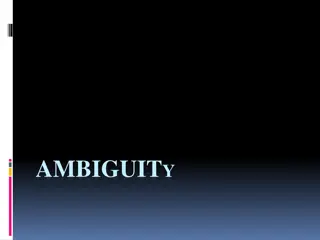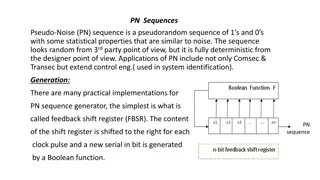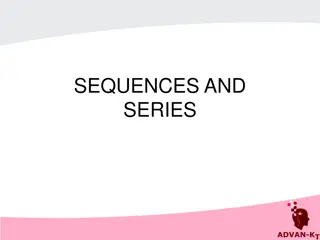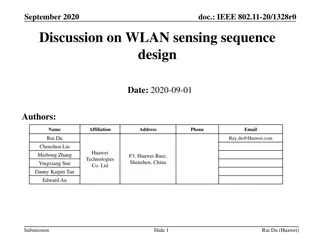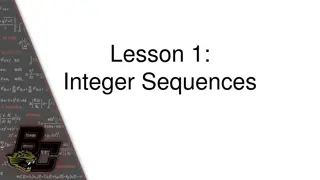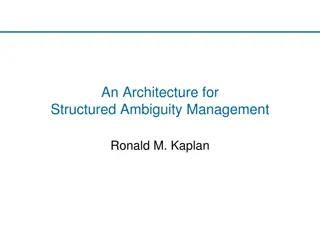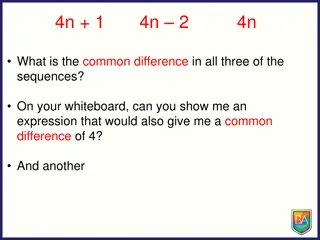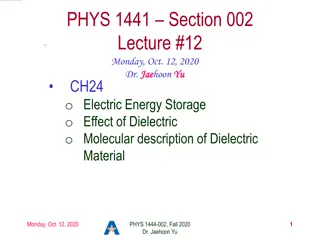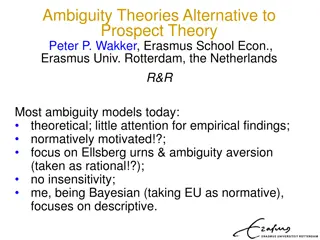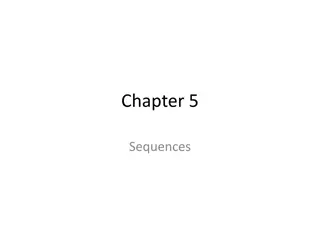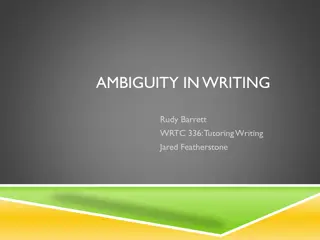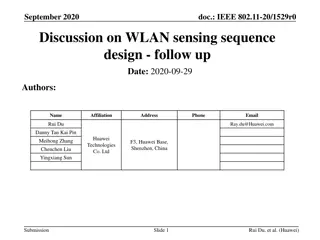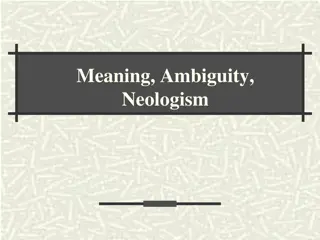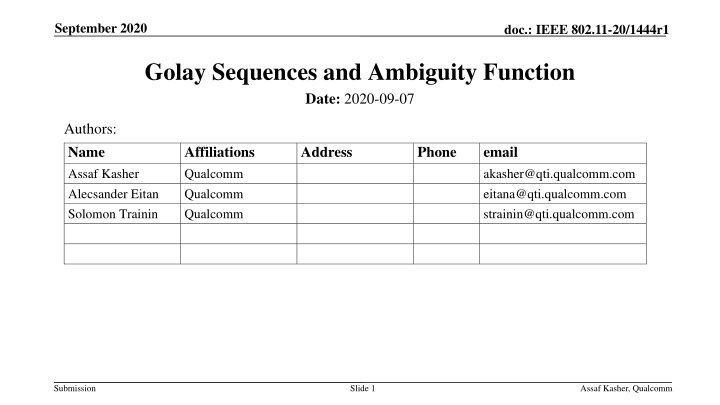
Utilizing Golay Sequences for Radar and Sensing Applications
Explore how Golay sequences can be effectively used for radar and sensing applications, particularly in the context of IEEE 802.11 standards. Learn about the ambiguity functions associated with Golay sequences and their applications in channel estimation and detection sequences. Discover the benefits of using Golay complementary sequences and their efficient correlators for improved performance in radar and sensing systems.
Download Presentation

Please find below an Image/Link to download the presentation.
The content on the website is provided AS IS for your information and personal use only. It may not be sold, licensed, or shared on other websites without obtaining consent from the author. If you encounter any issues during the download, it is possible that the publisher has removed the file from their server.
You are allowed to download the files provided on this website for personal or commercial use, subject to the condition that they are used lawfully. All files are the property of their respective owners.
The content on the website is provided AS IS for your information and personal use only. It may not be sold, licensed, or shared on other websites without obtaining consent from the author.
E N D
Presentation Transcript
September 2020 doc.: IEEE 802.11-20/1444r1 Golay Sequences and Ambiguity Function Date: 2020-09-07 Authors: Name Assaf Kasher Alecsander Eitan Solomon Trainin Affiliations Qualcomm Qualcomm Qualcomm Address Phone email akasher@qti.qualcomm.com eitana@qti.qualcomm.com strainin@qti.qualcomm.com Submission Slide 1 Assaf Kasher, Qualcomm
September 2020 doc.: IEEE 802.11-20/1444r1 Abstract This presentation discusses How Golay Sequences may be used for radar and sensing application and what their ambiguity function look like. Submission Slide 2 Assaf Kasher, Qualcomm
September 2020 doc.: IEEE 802.11-20/1444r1 Very Short Introduction to Golay Complementary Sequences Golay sequences are used in the DMG and EDGM clauses for detection sequences, channel estimation. Golay sequences come in pairs - ??,?? The main advantage of using Golay sequences: ???? ??,?? + ???? ??,?? = ? ? There is a very efficient (log(n) additions) correlator that generates the correlations of both Ga and Gb corr(s(n),Ga(n)) Golay Correlator s(n) corr(s(n),Gb(n)) Submission Slide 3 Assaf Kasher, Qualcomm
September 2020 doc.: IEEE 802.11-20/1444r1 How Can Golay sequences be used for Radar/Sensing Cyclic Prefic Cyclic Suffix Gu Gv Affects maximum progpagation time allowed -Ga128 -Gb128 -Ga128 Gb128 -Ga128 -Gb128 Ga128 -Gb128 -Ga128 -Gb128 Ga128 Gb128 Use the CE sequences as it is in the DMG/EDMG subclause Maximum Propagation delay limited to 128 samples (~10m) Allows usage of existing HW Possible Implementation: output of correlator (of both Ga and Gb) are summed with appropriate delay and sign change CE Transmit Sequences separately Allows for longer propagation delay without overlap Some use of existing HW Possible Implementation: Correlator outputs are summed with the appropriate delay Submission Slide 4 Assaf Kasher, Qualcomm
September 2020 doc.: IEEE 802.11-20/1444r1 How does this fit in an EDMG PPDU STF LTF Data TRN-Unit TRN-Unit TRN-Unit TRN-Unit Header Ga128 Gb128 -Ga128 -Gb128 -Ga128 Gb128 -Ga128 -Gb128 Ga128 -Gb128 -Ga128 -Gb128 One Option Another Option The sequences mentioned in the previous slide can be considered as modified TRN Units in an EDMG PPDU. Each sequence is a TRN-Unit, that may be transmitted in a different antenna setting (direction) Several PPDUs may be transmitted in different times to facilitate accurate doppler estimation. Submission Slide 5 Assaf Kasher, Qualcomm
September 2020 doc.: IEEE 802.11-20/1444r1 Performance of channel estimation version The upper figure shows the sum of 8 correlation with appropriate delays. We can see that there is a zero side lobes correlation zone of samples ( 72ns) The lower figure shows an ambiguity function with doppler shifts of 600Hz We can see that there is a 90dB difference between the peak and the sidelobes It is not possible to measure doppler shift in a single pulse using this sequence This a single Pulse Analysis, to find the speed of an object we need more than one pulse 128 Submission Slide 6 Assaf Kasher, Qualcomm
September 2020 doc.: IEEE 802.11-20/1444r1 Separated Ga and Gb The figure shows a pseudo ambiguity function based on the sum of correlation with Ga and Gb Maximum Doppler sidelobe ~80dB. Cannot detect doppler using a single pulse. Submission Slide 7 Assaf Kasher, Qualcomm
September 2020 doc.: IEEE 802.11-20/1444r1 Fractional Delay What happens when the delay is not a multiple of samples The figure shows the results for the worst case of 0.5 sample delay (implemented by DFT). We that the peak is spread over two samples and is 2 dB lower. Sync interpolation can recover the peak Submission Slide 8 Assaf Kasher, Qualcomm
September 2020 doc.: IEEE 802.11-20/1444r1 How can we estimate doppler using these sequences The figure shows a range- doppler map based on 64 pulse pairs Pulse pairs were separated by 100usec To get accurate doppler results, super resolution methods are needed (MUSIC/ESPRIT). Submission Slide 9 Assaf Kasher, Qualcomm
September 2020 doc.: IEEE 802.11-20/1444r1 Conclusions Golay sequences are a good candidate for sensing applications, especially if they are already present within the design. The ambiguity function is probably not a good measure for sequence quality it is measuring the ability of the sequence to enable both doppler and delay estimation in a single pulse. This is nearly impossible at the low speeds we are interested in due to phases noise between transmitter and receiver. Submission Slide 10 Assaf Kasher, Qualcomm
September 2020 doc.: IEEE 802.11-20/1444r1 References Submission Slide 11 Assaf Kasher, Qualcomm







